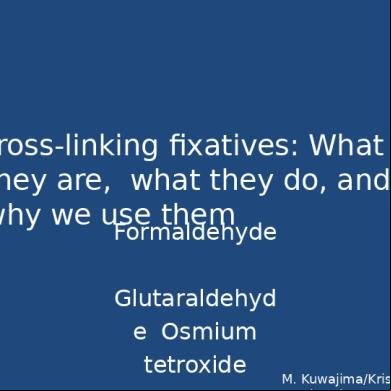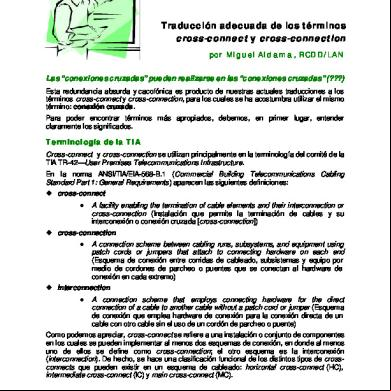Cross Linking Fixatives 4k6s68
This document was ed by and they confirmed that they have the permission to share it. If you are author or own the copyright of this book, please report to us by using this report form. Report 3i3n4
Overview 26281t
& View Cross Linking Fixatives as PDF for free.
More details 6y5l6z
- Words: 707
- Pages: 10
Cross-linking fixatives: What they are, what they do, and why we use them Formaldehyde
Glutaraldehyd e Osmium tetroxide M. Kuwajima/Kristen
EM processing and imaging demands better tissue fixation
LM EM • Visible light •
No vacuum (1 atm)
•
Live cells/tissue can be imaged.
•
Samples can contain water. Biological tissue has sufficient contrast.
• •
Formaldehyde fixation is often sufficient to preserve the tissue/cell.
• Electron beam (high energy) • High vacuum • Samples must be embedded into plastic. • Samples must be dehydrated. • Biological tissue is not electronopaque enough. need heavy metal stains • Tissue must be protected against subsequent EM processing and imaging.
•
Commonly used chemical fixatives for microscopy Cross-linking (additive) fixatives: e.g., formaldehyde, glutaraldehyde, acrolein, osmium tetroxide – Fixative molecules form cross-linkage with their targets. – Formaldehyde-glutaraldehyde mixture is the most commonly used primary fixative for EM (introduced by Karnovsky in 1965 [J Cell Biol 27:137A-138A]).
• Coagulants: e.g., EtOH, MeOH – Coagulate and/or precipitate proteins – Do not fix carbohydrates and lipids – LM only
• Acids: e.g., acetic acid, picric acid – precipitate proteins – Do not fix carbohydrates and lipids – LM only
Formaldehyde (or is it paraformaldehyde? What is formalin, anyway?) •
Formaldehyde = water soluble gas – When dissolved, it forms methylene hydrate – Methylene hydrate molecules can react with one another to form polymers – Small molecule = rapid penetration into tissue
•
Formalin = 37-40% formaldehyde (aq) with methanol (up to 15%), which prevents polymerization
• Paraformaldehyde = higher polymers (n
Formaldehyde reacts primarily with proteins Addition of formaldehyde (methylene glycol) to a lysine side-chain (fast)
Formation of methylene bridge with a neighboring nitrogen atom (slow)
•
The aldehyde group can react with nitrogen and some other atoms of proteins.
•
Methylene bridge (-CH2-) is formed between two reactive atoms in proteins that are very close together.
•
Other molecules (carbohydrates, lipids, nucleic acids) are thought to be trapped in a matrix of cross- linked proteins.
Methylene bridge
Glutaraldehyde (Quality fixation for EM since 1963) •
First introduced in 1963 as a fixative for EM (Sabatini DD et al. 1963. J Cell Biol 17:19-58)
• Two aldehyde groups per molecule, with a longer, flexible hyrocarbon chain – More efficient cross-linking – Small enough to penetrate tissue (slower than formaldehyde)
• Present in aqueous solutions as monomers and polymers of variable size
Glutaraldehyde readily cross-links proteins •
Both aldehyde groups of a single glutaraldehyde molecule react with proteins to form crosslinkage.
•
Glutaraldehyde can also react with phospholipids containing free amino groups (e.g., phosphatidylserine, phosphatidylethanolamine).
Cross-linking of proteins with glutaraldehyde monomer
Cross-linking of proteins with glutaraldehyde polymer
• Glutaraldehyde introduces free aldehyde groups to the fixed tissue
Osmium tetroxide (the multi-tasker) •
Introduced in 1948 by Claude
• Os can exist in nine oxidative states, five of which are reasonably stable. – Many potential chemical reaction pathways with many substrates.
• OsO4 is soluble in both polar (aqueous) and non-polar media. – Penetrate into, and react with, hydrophobic regions of tissue/cell (e.g., membrane phospholipids) – Water solubility: ~ 7% at RT
• Os is electron opaque. – Works as a stain, as well as a fixative
• OsO4 also acts as a mordant. – Enhancement of lead staining
• Limited penetration into tissue – Limit tissue section thickness to < 100µm
OsO4 reacts primarily with unsaturated lipids •
OsO4 reacts with C=C in unsaturated fatty acid chains of phospholipids – Reduction of Os during cross-linking reaction produces dark brown color in the processed tissue.
•
OsO4 can also react with some proteins and lipoprotein complexes.
Cross-linking of unsaturated fatty acid chains with OsO4
Ideal vs. practice of chemical fixation • •
Ideally, a good fixation method should preserve the cell/tissue as a whole. In practice, a chemical fixative is usually selective (e.g., aldehydes proteins). – Choose a fixative for molecule/structure of your interest, OR, – Use a combination of fixatives, OR, – Use a physical fixation method (i.e., rapid freezing)
•
•
Ideally, a good fixation method should preserve the cell structure with minimum change from the living state (volume, morphology, localization of macromolecules and organelles, etc.). In practice, fixation and tissue processing usually induces artifacts... – Minimize avoidable ones (e.g., swollen mitochondria).
Glutaraldehyd e Osmium tetroxide M. Kuwajima/Kristen
EM processing and imaging demands better tissue fixation
LM EM • Visible light •
No vacuum (1 atm)
•
Live cells/tissue can be imaged.
•
Samples can contain water. Biological tissue has sufficient contrast.
• •
Formaldehyde fixation is often sufficient to preserve the tissue/cell.
• Electron beam (high energy) • High vacuum • Samples must be embedded into plastic. • Samples must be dehydrated. • Biological tissue is not electronopaque enough. need heavy metal stains • Tissue must be protected against subsequent EM processing and imaging.
•
Commonly used chemical fixatives for microscopy Cross-linking (additive) fixatives: e.g., formaldehyde, glutaraldehyde, acrolein, osmium tetroxide – Fixative molecules form cross-linkage with their targets. – Formaldehyde-glutaraldehyde mixture is the most commonly used primary fixative for EM (introduced by Karnovsky in 1965 [J Cell Biol 27:137A-138A]).
• Coagulants: e.g., EtOH, MeOH – Coagulate and/or precipitate proteins – Do not fix carbohydrates and lipids – LM only
• Acids: e.g., acetic acid, picric acid – precipitate proteins – Do not fix carbohydrates and lipids – LM only
Formaldehyde (or is it paraformaldehyde? What is formalin, anyway?) •
Formaldehyde = water soluble gas – When dissolved, it forms methylene hydrate – Methylene hydrate molecules can react with one another to form polymers – Small molecule = rapid penetration into tissue
•
Formalin = 37-40% formaldehyde (aq) with methanol (up to 15%), which prevents polymerization
• Paraformaldehyde = higher polymers (n
Formaldehyde reacts primarily with proteins Addition of formaldehyde (methylene glycol) to a lysine side-chain (fast)
Formation of methylene bridge with a neighboring nitrogen atom (slow)
•
The aldehyde group can react with nitrogen and some other atoms of proteins.
•
Methylene bridge (-CH2-) is formed between two reactive atoms in proteins that are very close together.
•
Other molecules (carbohydrates, lipids, nucleic acids) are thought to be trapped in a matrix of cross- linked proteins.
Methylene bridge
Glutaraldehyde (Quality fixation for EM since 1963) •
First introduced in 1963 as a fixative for EM (Sabatini DD et al. 1963. J Cell Biol 17:19-58)
• Two aldehyde groups per molecule, with a longer, flexible hyrocarbon chain – More efficient cross-linking – Small enough to penetrate tissue (slower than formaldehyde)
• Present in aqueous solutions as monomers and polymers of variable size
Glutaraldehyde readily cross-links proteins •
Both aldehyde groups of a single glutaraldehyde molecule react with proteins to form crosslinkage.
•
Glutaraldehyde can also react with phospholipids containing free amino groups (e.g., phosphatidylserine, phosphatidylethanolamine).
Cross-linking of proteins with glutaraldehyde monomer
Cross-linking of proteins with glutaraldehyde polymer
• Glutaraldehyde introduces free aldehyde groups to the fixed tissue
Osmium tetroxide (the multi-tasker) •
Introduced in 1948 by Claude
• Os can exist in nine oxidative states, five of which are reasonably stable. – Many potential chemical reaction pathways with many substrates.
• OsO4 is soluble in both polar (aqueous) and non-polar media. – Penetrate into, and react with, hydrophobic regions of tissue/cell (e.g., membrane phospholipids) – Water solubility: ~ 7% at RT
• Os is electron opaque. – Works as a stain, as well as a fixative
• OsO4 also acts as a mordant. – Enhancement of lead staining
• Limited penetration into tissue – Limit tissue section thickness to < 100µm
OsO4 reacts primarily with unsaturated lipids •
OsO4 reacts with C=C in unsaturated fatty acid chains of phospholipids – Reduction of Os during cross-linking reaction produces dark brown color in the processed tissue.
•
OsO4 can also react with some proteins and lipoprotein complexes.
Cross-linking of unsaturated fatty acid chains with OsO4
Ideal vs. practice of chemical fixation • •
Ideally, a good fixation method should preserve the cell/tissue as a whole. In practice, a chemical fixative is usually selective (e.g., aldehydes proteins). – Choose a fixative for molecule/structure of your interest, OR, – Use a combination of fixatives, OR, – Use a physical fixation method (i.e., rapid freezing)
•
•
Ideally, a good fixation method should preserve the cell structure with minimum change from the living state (volume, morphology, localization of macromolecules and organelles, etc.). In practice, fixation and tissue processing usually induces artifacts... – Minimize avoidable ones (e.g., swollen mitochondria).





